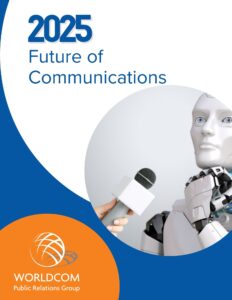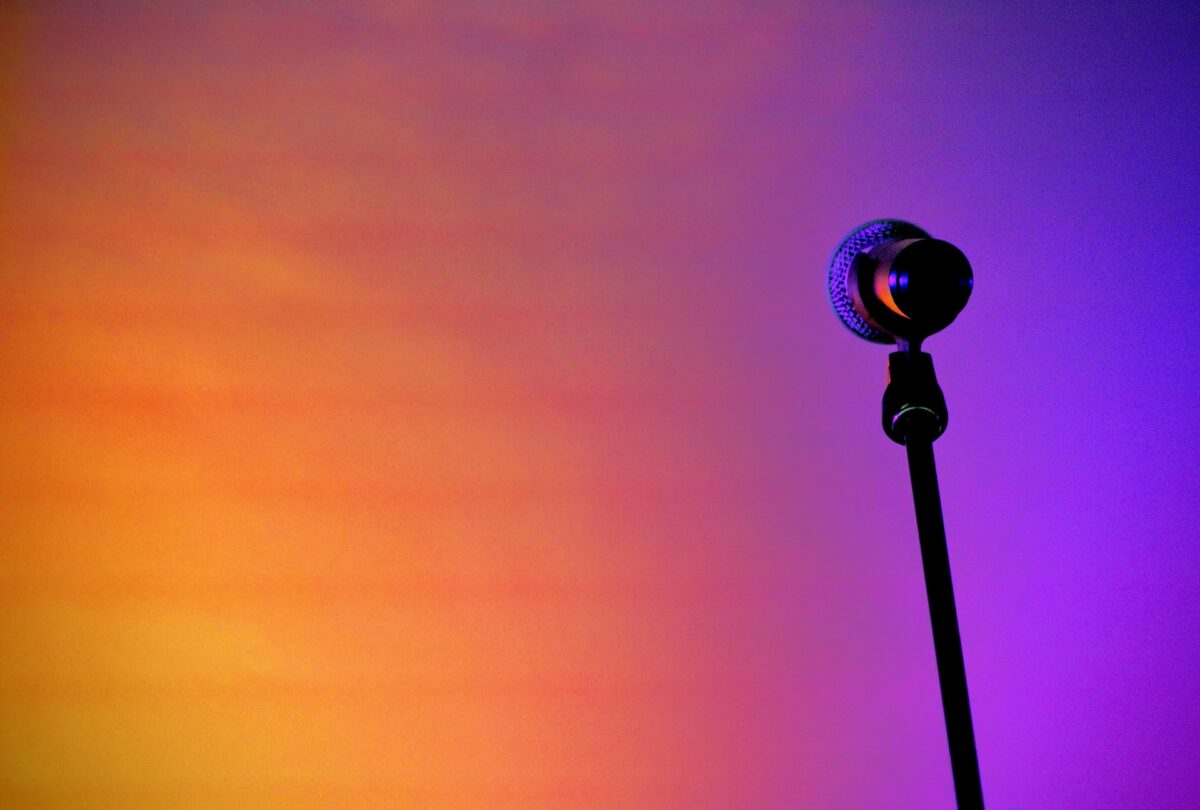Getting more for 2024 with the help of our Worldcom experts
As organizations turn their thinking to their business objectives and communications strategies for 2024, we asked our Worldcom communications experts from around the world to share their thoughts on issues, trends and techniques that could help communications professionals deliver more for 2024. Their thoughts have been captured in a downloadable guide that addresses ESG, crisis management, fintech, AI, brand purpose, employee engagement, talent retention, the importance of data to drive outcomes, food and health, travel and tourism, immersive events, crisis communications and the effective use of imagery.
DOWNLOAD THE GUIDE ON THE EMERGING TRENDS IN THE EVER-SHIFTING COMMUNICATIONS LANDSPACE
This post shares five of the expert contributions. We hope you find them useful in shaping your plans and strategies so that you achieve more in 2024.
Deciding when to take a stand on social issues – Julie McCracken
Everywhere you look, there’s a new, potentially polarizing issue emerging. There was a time when people wouldn’t even consider bringing some of these topics up at their dinner table. Now, they expect companies to not only have a point of view, but to take a stand.
In fact, consumers have higher expectations that brands and CEOs speak out and take a stand on an issue than they did just two years ago. Numerous studies demonstrate that consumers are willing to pay more for products from companies who have similar values and beliefs, are more brand loyal to those organizations, and are more willing to offer them grace in the face of adversity.
But you can’t be all things to all people, and you can’t speak out on everything. So as an organization, how do you know when you should take a stand on an issue?
It’s not easy, and these decisions can have major business implications. When deciding whether or not to take a stand on an issue, consider these four key points.
- Does the issue align with your company’s vision, mission and brand? It’s important to separate personal feelings from what makes sense for the business.
- Have you considered all points of view? While one group of stakeholders may feel extremely passionately one way, there’s likely to be another group that feels the opposite. Consider ALL points of view and remember social issues are viewed differently around the globe.
- Are you adding value to the conversation, or just another voice? Don’t take a stand just to be heard – consumers will see through you. If you’re going to speak out, make sure you’re contributing something meaningful to the conversation, actively committing to/driving change or offering solutions.
- Are you walking the talk? By taking a stand or speaking out, you’re opening yourself up to scrutiny. Be prepared to show what you’re doing to be part of the solution, and make sure your internal house is in order.
Interested in learning more? Connect with us at contact Padilla.
Julie McCracken, vice president, Padilla, is a member of the agency’s Corporate Advisory Group, and focuses on social impact, employee engagement, corporate culture and change communications. Padilla, Minneapolis, USA.
AI’s Transformative Role in Fintech PR – Stefan Pollack
Fintech is experiencing an unparalleled revolution courtesy of Artificial Intelligence (AI). As these tech-savvy financial firms continue to reshape how we interact with money, their PR strategies are evolving, too, leveraging AI’s potent capabilities. For fintech firms aiming to carve their niche in a hyper-competitive landscape, AI isn’t just an asset; it’s a necessity.
Why It’s Important:
For financial services and fintech, trust is currency. And for tech companies, staying innovative and relevant is vital. The industry promises disruption, and every communication and campaign signals to stakeholders just how transformative fintech can be. With AI, PR efforts can be laser-targeted: sentiment analysis gives real-time feedback, predictive algorithms guide content strategy, and automation ensures timely engagement.
Here are key insights to keep in mind:
- AI-Driven Analytics is Your Compass: Navigate the vast seas of stakeholder data and interactions using AI. Its insights will shape and refine resonant PR campaigns.
- Anticipate with Predictive Engagement: Use AI’s foresight to gauge market and stakeholder reactions, letting you stay ahead in your communication strategies.
- AI Ethics & Data Transparency Are Non-Negotiable: Fintech organizations must be transparent in an industry built on trust. Ensure stakeholders know how AI tools process their data, fortifying trust and transparency.
- Stay Agile with Continuous AI Learning: The fintech landscape evolves relentlessly. Ensure AI tools and strategies adapt and innovate at a similar pace.
- Automate, but Personalize: While AI can automate many PR processes, ensure the touch of personalization remains. Tailored messages, even if AI-generated, strike deeper chords.
The intersection of AI and fintech presents a transformative shift in the financial world. As digital innovations continually redefine our financial interactions, AI emerges as a linchpin, ensuring fintech firms communicate effectively, strategically, and ethically. Embracing the intelligence and insights offered by AI isn’t merely about keeping pace with industry evolution. It’s about leading from the forefront, pioneering new-age financial dialogues, and setting benchmarks for others. For fintech firms eyeing leadership and influence, integrating AI into their PR arsenal is the unequivocal way forward.
Interested in learning more? Connect with us at [email protected]
Stefan Pollack is President & CFO of The Pollack Group, Los Angeles, USA
The Importance Of Driving Belief and Belonging to Achieve Your Business Objectives – Crispin Manners
The three extracts below from current articles focus on three different actions to take to create a PeopleFirst organization. The first in Entrepreneur.com by Terrell Strayhorn, PHD focuses on the benefits of creating a sense of belonging.
‘When employees feel a sense of belonging in the workplace, they’re free to be their authentic, true selves, which makes it easier to show up, engage with others, create solutions and perform well. People who don’t feel workplace belonging experience anxiety, (dis)stress and mistrust that ultimately hampers their performance and creativity. That’s why entrepreneurs and leaders should design organizational policies and practices to encourage it.’
But what do you need to do to create belonging. The extract below from an excellent article by Matt James in Psychology Today highlights the importance of Inspiring Leadership and communication to creating a PeopleFirst organization.
‘Picture this: you’re a leader with high EQ. Your team looks up to you because you inspire them, foster collaboration, and make decisions that take everyone’s emotions into account. Effective communication is your superpower. By building rapport, listening actively, and speaking with empathy, you create a positive work environment where ideas flow freely. Leaders with high EQ inspire teams, foster a positive work culture, and drive productivity.’
Then there is this extract from a CNBC article by Goh Chiew Tong which show that having an inspiring and inclusive culture is just as important as inspiring leadership.
‘A toxic workplace culture was one of the biggest culprits behind the Great Resignation — which saw droves of workers leaving their jobs or switching careers during the post-pandemic era.
But since then, some companies are moving to the other extreme of “a culture of niceness,” and that could be just as damaging as toxicity, said one social psychologist.’
 These three articles show that becoming PeopleFirst is a journey that will never be fully completed because things change. What you focus on depends on where you are on that journey. So, it makes sense to find out where you are positioned on the PeopleFirst Matrix and whether there is alignment between senior leadership, line management and employees.
These three articles show that becoming PeopleFirst is a journey that will never be fully completed because things change. What you focus on depends on where you are on that journey. So, it makes sense to find out where you are positioned on the PeopleFirst Matrix and whether there is alignment between senior leadership, line management and employees.
Interested in learning more? Connect with us at [email protected]
Crispin Manners is CEO of Onva Consulting and Chairman of Inspiring Workplaces, UK.
“Food is Medicine”: A New Horizon for the Food Industry – Maya Maroto
In recent years, the adage “food as medicine” has surged in popularity, emphasizing the potential for the foods we consume daily to promote health and prevent disease. While fruits and vegetables have traditionally been at the epicenter of this dialogue, a broad spectrum of foods can contribute to holistic, disease-preventing dietary patterns.
As insurance companies, academic institutions and governmental bodies continue to explore nutrition’s role in health management, a unique opportunity arises to identify the ideal dietary pattern(s), delivery format, and duration to enhance health outcomes. This beckons all food industry stakeholders to collaborate and become pioneers in this evolving space.
Three Key Strategies for Food Industry Engagement in “Food is Medicine”:
- Narrate the Public Health Significance: For inclusion in this movement, food must offer a definitive public health benefit. It’s essential to communicate which diseases or populations might benefit from your product and the scientific evidence backing these claims. By substantiating a product’s role in disease prevention or management, food industry stakeholders can solidify their position in food is medicine interventions.
- Foster Cross-Industry Partnerships: Building relationships with insurers, food retailers, non-profits, and health organizations is crucial. Collaborative endeavors allow the food industry to have a voice in shaping the future of the food is medicine movement. Strategic partnerships open doors to additional opportunities to integrate a wider mix of foods into food is medicine programs.
- Develop Advocates: To gain traction, industry players should seek and support champions—those echoing their mission. By wielding evidence-based nutrition insights, these advocates can amplify the role of specific foods in health promotion. All nutritious food products warrant acknowledgment in the food is medicine discourse. It’s the food industry’s moment to engage and accelerate the integration of food into the healthcare system.
Interested in learning more? FoodMinds has dedicated experts tracking all things Food is Medicine. Connect with us at [email protected]
Maya Maroto, EdD, MPH, RDN is a Vice President at FoodMinds, a division of Padilla, based in our Washington, DC office. She leads our Food is Medicine team.
Embracing AI for Marketing Success: True’s Expertise – Wayne Silasi
The integration of artificial intelligence (AI) into marketing strategies is reshaping the landscape, offering a range of powerful tools. This transformation spans generative AI, predictive analytics, and large language models (LLMs). These advancements can potentially revolutionize marketing, presenting both opportunities and challenges.
Marketers harness these capabilities to craft compelling content like blog posts and images; however, this isn’t AI’s sole advancement. Predictive analytics empowers businesses to forecast future earnings with precision, guiding decision-making for well-defined goals.
AI’s influence even extends to investment advice, enhancing prediction accuracy and efficiency. Moreover, open-sourced LLMs like Llama 2 are democratizing access, encouraging innovation and spurring exponential growth. Embracing AI isn’t just smart—it’s imperative. At True, we’re working with our clients to better understand the role of AI in marketing. One thing is certain: you can either lead or fall behind – and staying relevant hinges on staying updated.
For the industries True specializes in, such as construction and manufacturing, AI holds significance. It creates efficiency, streamlines processes, and optimizes operations. While AI doesn’t lay bricks, it helps shape the blueprint, freeing us humans from menial tasks for grander visions. So, how should other marketers address this trend and capitalize on AI?
Adopt a phased strategy
Crawl, Walk, Run. Integrate AI into everyday tasks, such as composing emails and task prioritization – small yet impactful steps. As familiarity grows, explore avenues to implement it on a larger scale within your organization.
Embrace AI’s versatility
AI or LLMs can often be augmented or trained on a business’s own data, adding more intelligent and relevant information to the user. Look to leverage these opportunities to extract the most value possible from your AI Tools and applications.
Acknowledge AI’s rise but comprehend the associated risks
Prevent bias in AI models, address copyright concerns in generative AI, and uphold ethics—use AI judiciously.
In the era of AI, seizing opportunities while navigating challenges will define successful marketing strategies. But remember, staying ahead of the times is the key. Embracing modern tech is no longer a choice but a necessity for thriving in the ever-changing business landscape.
Interested in learning more? Connect with us at [email protected]
Wayne Silasi is Digital Marketing Lead at True Digital Communications, Cleveland, USA
If you would like to discuss your plans with a Worldcom expert in your country, please contact us here.

Do you want to know what is coming in 2025?
In 2024, most of our partners around the world had specific advice about the emergence of Artificial Intelligence (AI) in Public Relations. From creating company policies around ChatGPT use to how AI would improve marketing performance, the change has been more rapid that most businesses and practitioners could have predicted.
For 2025, the influence of AI can be seen in every discipline from social media to crisis management to media management.





